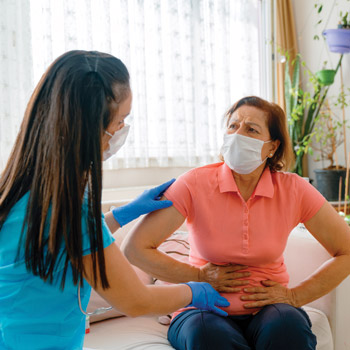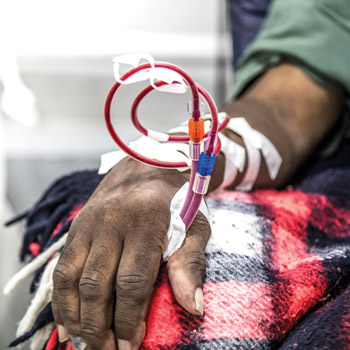Beyond PPIs for persistent GERD
Consider whether the patient has gastroesophageal reflux disease (GERD) that isn't responding to proton-pump inhibitors (PPIs) or GERD symptoms without an objective GERD diagnosis.
In patients with symptoms of gastroesophageal reflux disease (GERD) that are not responding adequately to proton-pump inhibitors (PPIs), consider two scenarios, said Rena H. Yadlapati, MD, MSHS.
“Is this a patient that has GERD with PPI-nonresponsive symptoms?” she asked. Or, alternatively, does the patient have GERD symptoms without an objective GERD diagnosis? At a session at ACG 2020, the American College of Gastroenterology's annual meeting, which was held virtually last October, Dr. Yadlapati offered some tips on distinguishing one scenario from the other and managing patients' symptoms.

“We know that symptom presentation and questionnaires are poorly sensitive for GERD,” said Dr. Yadlapati, who is an associate professor of clinical medicine and medical director of the Center for Esophageal Diseases and Motility Program at the University of California, San Diego.
“Where the clinical presentation can help us is in picking up on other factors in the patient's history,” she said. For example, patients who have central obesity, delayed gastric emptying, and known hiatal hernia could benefit from recommendations on modifying their lifestyle, including weight loss evaluation.
Other issues may include underlying comorbidities that augment reflux. One example is patients with scleroderma, which often involves hypomotility and reduced clearance of reflux.
“Or if you get the gut sense, no pun intended, that your patient is hypervigilant about their symptoms, perhaps hypervigilance is a contributor or even driver of their symptoms,” Dr. Yadlapati said. “For all patients that present with reflux symptoms, we now review the brain-gut association in clinic, and it is incredible to see how empowering it is for patients to know that they have some control over their symptom awareness.”
Testing, monitoring
According to the ACG's 2020 guidelines on esophageal physiologic testing, published by the American Journal of Gastroenterology last August, a PPI trial is reasonable if reflux is suspected in a patient with esophageal symptoms, Dr. Yadlapati said. For patients with extraesophageal symptoms, or those with esophageal symptoms in whom a PPI trial has failed, the next steps should be upper endoscopy and reflux monitoring.
Upper endoscopy allows careful inspection of the mucosa and evaluation for erosive esophagitis, Barrett's esophagus, and peptic stricture, “but we know that in the majority of patients, the esophagus will look normal,” Dr. Yadlapati said. Endoscopy can also evaluate the anatomic integrity of the antireflux barrier and help diagnose hiatal hernia as well as other conditions, such as esophageal motor disorder.
“If on endoscopy the patient has erosive reflux disease, then we don't need to test any further. We've already clinched our diagnosis of GERD,” Dr. Yadlapati said. In patients with normal esophageal findings on endoscopy, however, “this is an indication to pursue pH monitoring off acid suppression to really distinguish between the patient that has nonerosive GERD versus the patient that doesn't even have GERD to begin with.”
There are two options for ambulatory reflux monitoring, a wireless pH capsule or a pH impedance catheter, Dr. Yadlapati explained. The former is typically placed transorally during a sedated endoscopy and allows prolonged monitoring up to 96 hours, accounting for day-to-day variability in acid exposure. The pH impedance catheter, in contrast, is usually placed after manometry without sedation.
“In a patient that doesn't want to take time off of work or can't have a driver with them, this may be optimal. Also given that it has pH sensor in addition to impedance sensors, we have the ability to detect nonacidic reflux and bolus flow,” Dr. Yadlapati said. However, she stressed that interpretation of pH impedance is more involved than wireless pH monitoring. “It requires adequate time, adequate expertise, and so this is very important to keep in mind when you're choosing between the systems as well.”
The diagnostic metrics of interest for ambulatory reflux monitoring are acid exposure time and reflux events over 24 hours, she said. An acid exposure time over 6% and more than 80 reflux events is consistent with pathologic GERD, whereas an acid exposure time less than 4% or less than 40 reflux events is considered normal. “And then, of course, there's a gray zone,” she said, which includes patients with an acid exposure time of 4% to 6% and 40 to 80 reflux events.
Reflux monitoring also offers the ability to associate a patient's symptoms with actual reflux events, Dr. Yadlapati noted. Patients with a symptom index over 50%, meaning more than 50% of their symptoms are associated with reflux, and a symptom association probability greater than 95% are considered to have positive symptom reflux association, she explained.
“When you have this and someone already has known pathologic GERD, this indicates a patient that's at a high likelihood of symptom response with antireflux management,” she said. “Now, if you have a positive symptom reflux association and a patient that falls in this gray zone, this may increase your confidence in GERD pathology, and it also may hint to a component of a hypersensitive mechanism.” Patients without objective GERD but a positive symptom reflux association, meanwhile, can be diagnosed with esophageal hypersensitivity, she said.
Reasons for nonresponse
Patients who have not responded to PPI therapy but are found to have objective GERD on upper endoscopy may not be taking their PPIs appropriately, Dr. Yadlapati said. “Oftentimes, patients think they should be taking their evening dose before bedtime rather than prior to dinner, and so providing counseling that the PPI should be taken about 30 minutes before a meal on an empty stomach can be a very easy recommendation that can really make quite a difference,” she noted.
It's also possible that patients are taking their medications correctly but have the CYP2C19 metabolism genotype, which does not allow optimal acid suppression, Dr. Yadlapati said. “For these patients, if we suspect it or if we actually test for the genotype and they're found to be positive, we'll switch the PPI to rabeprazole or esomeprazole, as these are less metabolized through the CYP2C19 pathway.”
Data also show that reduced nocturnal acid exposure and symptom relief can be provided by adjunctive H2 blockers, she said, “keeping in mind that there was an FDA recall last year of ranitidine and so oftentimes we will recommend famotidine or cimetidine for patients these days.”
Patients also may not respond to PPIs because their symptoms are not entirely due to acid, Dr. Yadlapati noted. In patients with an intact antireflux barrier, the primary mechanism of reflux is transient lower esophageal sphincter (LES) relaxations, where the crural diaphragm is sometimes inhibited. “The lower esophageal sphincter relaxes in absence of swallowing, and this may be accompanied by a reflux episode,” she said. “And so for these reasons, it's plausible that inhibiting transient LES relaxation may be efficacious.”
Gamma aminobutyric acid (GABA) agonists, primarily baclofen, have shown promise for this indication in clinical studies, Dr. Yadlapati said. For example, a meta-analysis of nine randomized controlled trials published in October 2014 by Gastroenterology Research and Practice found that GABA agonists reduce the number and average length of reflux episodes, as well as the incidence of transient LES relaxations.
“It's important to note that clinically and anecdotally, patients do struggle with baclofen due to its [central nervous system] side effects, as well as GI side effects,” Dr. Yadlapati said. “And so, in a few patients when other adjunctive therapy has failed, and they have an intact antireflux barrier, we will trial baclofen, but we usually start at a low dose at nighttime, and then we titrate up if they're tolerating it.”
For patients with an impaired antireflux barrier such as hypotensive LES or a hiatal hernia, however, their mechanism of reflux does not primarily involve transient LES relaxation, and a trial of baclofen may have no effect. The mechanism of reflux is more mechanical, meaning that a strain can increase intra-abdominal pressure and induce reflux, Dr. Yadlapati said, “or you can even have free reflux without any change in intra-abdominal pressure. Sometimes swallowing can induce LES relaxation in patients with a hernia, and this can lead to re-reflux of bolus from the hernia itself.” Mechanical restoration of the antireflux barrier, involving antireflux surgery or endoscopic fundoplication, is often needed in these cases, she noted.
Approximately 50% of patients may not benefit from PPIs because they have reflux hypersensitivity and hypervigilance and don't have GERD at all. “We've really come to appreciate this phenomenon much more in recent years,” Dr. Yadlapati said. A patient may experience common reflux symptoms that trigger enhanced sensitivity to physiological stimuli and increased symptom awareness, leading to fear, stress, anxiety, and maladaptive coping, she explained.
Treatments for hypersensitivity include neuromodulation with low-dose antidepressants. “Typically, I'll start with amitriptyline, 25 milligrams at bedtime, and then titrate the dose depending on their tolerance and their side effects,” Dr. Yadlapati said. She noted that behavioral interventions also play a role and that support in the literature is growing for psychology-guided interventions like cognitive behavioral therapy, esophageal-directed hypnotherapy, and relaxation strategies.
Another reason patients may not respond to PPI therapy is that they have a behavioral disorder such as rumination or supergastric belching, Dr. Yadlapati said. These can be detected easily on postprandial, high-resolution manometry, where patients are monitored for about 30 to 60 minutes after intake of an aversive digestive stimuli, she noted.
“This is critical because these patients don't do well with antireflux surgery, but they may do well with cognitive behavioral therapy, and just understanding the physiology of why they're experiencing their symptoms,” she said.
Finally, patients may have an alternate esophageal pathology, such as an esophageal motor disorder that is responsible for their symptoms.
“PPI nonresponse is prevalent, and patients that present with PPI nonresponse are clearly heterogeneous,” Dr. Yadlapati concluded. “All of this is associated with the tremendous quality-of-life impairment and health care expenditure.”
She stressed that a practical, stepwise framework that begins with the clinical presentation, moves to objective testing when indicated, and involves additional physiologic testing when warranted can help optimize diagnostic yield while minimizing risk and cost. “And finally,” she said, “we really need to personalize therapy to the mechanism of the patient's nonresponse.”




